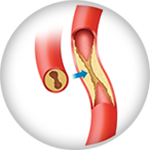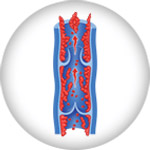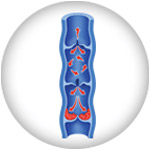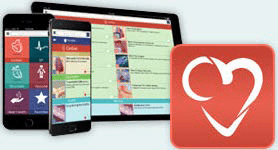Excercise Pain
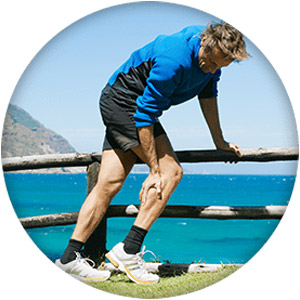
Symptom Details
Not all individuals with PAD or venous disease will develop symptoms. But for those that may develop exercise pain, the Rutherford Classification is a common system that is widely used to diagnose and identify the severity of arterial disease as it progresses with time.
Rutherford Classification 5
| Stage 0 | Stage 1 | Stage 2 | Stage 3 | Stage 4 | Stage 5 | Stage 6 |
| No symptoms | Some exercise pain after walking long distances | Exercise pain that occurs more frequently at shorter distances | Severe exercise pain that happens frequently after a short distance | Pain in the legs, calves, buttocks that occurs despite rest | Leg ulcers begin to develop | Severe non‑healing wounds can lead to gangrene or tissue loss |
Because claudication is a symptom of serious arterial and venous conditions that worsen, it is important to seek help from your doctor to obtain a proper diagnosis.
Causes
Exercise pain is a symptom of underlying diseases and conditions that cause the arteries in the extremities to become blocked or narrowed.1 When you are engaged in activity, your body needs extra blood flow to the area. But when your blood vessels are blocked, you may not get as much blood as your body needs, which leads to the pain. The pain typically subsides at rest because your body requires less blood flow at that time. Several venous conditions, such as deep venous disease (DVD), may also contribute to exercise pain. Because of vein valve malfunction, it can be difficult for the veins to send blood back to the heart and can result in pain while in motion.
Risk Factors

Like many other PVD conditions and symptoms, there are certain risk factors that can increase the likelihood of developing exercise pain. 1,4 These risks include:
What to Look For
Sometimes people can experience exercise pain when they have injured their muscles. But if you have chronic and persistent exercise pain or you have a noticable decrease in your exercise tolerance, it is important to take the step and see your doctor. Exercise pain can be a sign of peripheral artery disease (PAD), a progressive condition that results from plaque build-up and restricted blood flow.1,2 Affecting approximately 10 percent of those with PAD, the symptom can produce cramping pain in the muscles during exercise. You may notice changes or reductions in your exercise tolerance or threshold, meaning you can’t walk as far or exercise for as long. In addition, you may feel like you are walking with heavy weights on your legs.4 Venous conditions such as deep venous disease (DVD) and deep vein thrombosis (DVT) can also produce exercise pain. When blood flow is obstructed, people may feel throbbing or radiating pain up and down the leg. When you first experience exercise pain, it may come and go only when you are active. But as the underlying condition progresses, the pain may worsen even when you are not active. Here are signs of symptom progression:1,3
Mild
Moderate
Severe
Associated Symptoms
Tired, heavy legs
Bothersome leg discomfort may include pain, tiredness and heaviness. This is the result of increased venous pressure in the legs due to PVD.
Pain at rest
As PAD progresses, obstruction of blood flow in the blood vessels can become severe to the point that pain develops even while at rest. This is a serious condition that may indicate the advanced stages of arterial disease, critical limb ischemia (CLI).
Non-healing wounds
Poor blood circulation can lead to skin break down and open wounds, or ulcers, that require prompt medical attention. When sores are open, bacteria can grow and make the ulcers worse.
When to See a Doctor
Exercise pain may be a sign of a serious venous or arterial disease. Appropriate treatment of these conditions is important not only to prevent progression of disease. If you notice intermittent pain during exercise in your legs, it is important to take the step to get help right away. Talk to your doctor, or use our tool to locate a doctor to consult for a diagnosis.
Associated PVD Diseases
Helpful Resources

PVD Doctor
Discussion Guide
Get helpful tips and advice on how to talk to your doctor about a PVD screening.

Patient Brochures
Third-Party Resources
Helpful Websites
Blogs
Apps
A mobile app built by cardiologists, to simplify understanding of most cardiac and peripheral vascular conditions and treatments.
Find a Doctor that Treats PVD
Consult your doctor to learn more about PVD and how to maintain your health. You can also use our Doctor Finder tool below to find a specialist near you.
This tool is not inclusive of all specialists. Consult with your insurance provider to find specialists that are covered within your network.
Are You a Healthcare Professional?
Find out how to register your practice with us.
1. “Claudication.” Mayo Clinic. Mayo Foundation for Medical Education and Research, 31 Jan. 2015. 2. Simon et al. “Peripheral artery disease and intermittent claudication.” University of Maryland Medical Center. May 24, 2012. 3. “Claudication.” John Hopkins Medicine. n.d. 4. “Peripheral arterial disease.” National Heart, Lung, and Blood Institute. n.d. 5. Hardman et al. “Overview of Classification Systems in Peripheral Artery Disease.” Semin Intervent Radiol. 2014 Dec; 31(4): 378–388.
Disclaimer
The opinions and clinical experiences presented herein are for informational purposes only. Individual results may vary depending on a variety of patient-specific attributes and related factors. Dr. Raghu Kolluri has been compensated by Philips for his services in preparing and providing this material for Philips further use and distribution. We offer links to third-party websites that may be of interest to our website visitors and in no way, represent any affiliation or endorsement of the information provided on those linked websites. These links are provided solely for your convenience and to assist you in learning more information on this topic. However, Philips does not control, endorse or guarantee the accuracy of the information contained on the linked sites. In addition, Philips makes no representations or warranties of any kind with regards to any third-party websites or information contained therein. If you have any questions or concerns about the information on the linked third-party websites, please contact the third-party websites directly.
